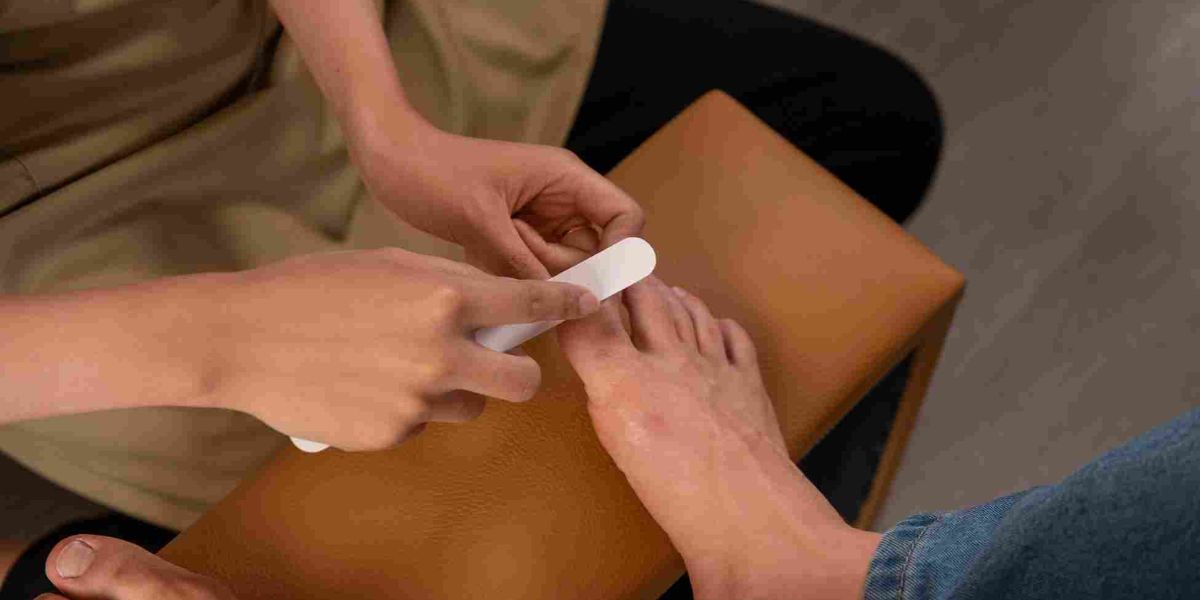Keeping your feet healthy starts with something simple yet often overlooked — proper nail care. Here’s how to clip your toenails to prevent ingrown toenails without pain or future problems. This guide blends expert podiatry advice with easy, practical steps so you can avoid common nail trimming mistakes and keep your toes comfortable. Whether you’re dealing with curved toenails or just want to improve your toenail health, learning the correct nail cutting technique is key. With the right habits, you can lower your risk of painful conditions and enjoy trouble-free walking, running, or relaxing — every single day.
What Is an Ingrown Toenail?
An ingrown toenail happens when the edge of your nail grows into the surrounding skin. This can cause redness, swelling, and pain. It’s more common in big toes but can happen to any toe. Many people think it’s just a minor problem, but if ignored, it can lead to infection signs and serious foot issues.
In the USA, podiatry advice shows that factors like footwear fit, injury, and nail trimming mistakes increase the risk. Early detection is key. If you feel pain or see skin growing over your nail edge, you might already have an infected toenail that needs attention.
Causes of Ingrown Toenails
One of the main causes of ingrown nails is poor nail trimming habits. Cutting nails too short or making deep, curved edges encourages the nail to push into your skin. Wearing shoes that are too tight or too narrow also plays a big role, especially for people with curved toenails.
Other reasons include toe injuries, athlete foot safety issues, and even genetics. Some people naturally have nail shapes that are more likely to prevent nail growth into skin improperly. For people with diabetic foot care needs, the risk is even higher due to slower healing.
How to Identify an Ingrown Toenail
The first ingrown toenail symptoms usually include mild swelling and tenderness along the nail edge. As the condition worsens, you may see infection signs like pus, increased redness, and heat in the toe. These should never be ignored.
It’s important to know the difference between an ingrown toenail and other toe problems. A fungal infection changes the color and texture of your nail, while an ingrown nail causes direct pain where the nail meets the skin. Understanding these differences helps with faster and more accurate home toenail care.

Best Techniques for Clipping Toenails Correctly
Following a safe toenail trimming method can prevent future problems. Always aim for a nail edge straight cut rather than a deep curve. This reduces pressure on the skin and lowers the risk of the nail growing inward.
Here’s a table showing the right way versus the wrong way:
| Correct Nail Cutting Technique | Nail Trimming Mistakes |
| Leave a small amount of white nail | Cutting nails too short |
| Cut straight across | Making deep side cuts |
| Use clean, sharp clippers | Using dull tools |
| Trim after a shower (soft nails) | Trimming dry, brittle nails |
If you follow these toenail cutting steps regularly, you’ll improve your overall toenail health and avoid common problems.
Preventive Foot Care Tips
Good foot hygiene is the foundation of toenail health. Wash your feet daily, dry them well, and keep your nails at a proper toenail length. Always wear shoes that have enough space for your toes, and choose breathable materials to avoid moisture buildup.
Maintaining a nail maintenance routine can also help. Trim nails every 4–6 weeks, depending on how fast they grow. People who run, hike, or wear closed shoes for long hours should be extra careful to keep a footwear fit that doesn’t cause pressure on the toes.
Home Remedies for Mild Ingrown Toenails
For mild cases, a warm saltwater soak can reduce swelling and soften the skin. Soak for 15–20 minutes, 2–3 times daily. After soaking, gently lift the nail edge with a clean tool and place a small cotton piece under it to encourage proper growth.
Always keep the area clean and dry. Use antiseptic creams if needed. However, if you see worsening infection signs, avoid aggressive home toenail care and seek professional toenail treatment instead.
When to See a Podiatrist or Doctor
You should schedule a podiatrist appointment if home remedies don’t help within a few days or if the toe is severely swollen, red, or leaking pus. People with diabetic foot care concerns should see a doctor immediately when any ingrown toenail symptoms appear.
During the visit, your doctor will check the severity and may recommend minor procedures. They will also give podiatry advice for long-term prevention. Knowing what to expect can reduce anxiety about treatment.
Medical Treatments for Ingrown Toenails
If the nail is deeply embedded, a partial nail avulsion might be needed. This nail removal procedure removes part of the nail to relieve pressure and allow the skin to heal. In severe cases, a nail matrix removal is done to stop regrowth in the affected area.
Recovery usually takes a few weeks. Keeping the foot clean, wearing open-toed shoes, and following podiatry advice ensures better healing. Medical care can also prevent future curved toenails from causing the same issue.
How to Prevent Recurrence
Once healed, focus on habits that prevent nail growth into skin. Continue with safe toenail trimming, choose a footwear fit that gives your toes space, and keep your nails at a proper toenail length.
Special groups like athletes should follow athlete foot safety measures, while people with diabetes must stick to strict nail maintenance routine schedules. Prevention is always easier than treatment.
Common Myths and Mistakes About Ingrown Toenails
One myth is that cutting a deep “V” in the middle of the nail will fix the problem. In reality, this doesn’t work and can make the nail weaker. Another mistake is doing risky home toenail care when the nail is already infected.
Avoid any nail trimming mistakes like avoid deep side cuts, using dirty tools, or ignoring pain. Trust professional toenail treatment if you’re unsure. Correct knowledge and careful habits keep your toes healthy for years.
FAQs
Q: What is the best way to cut your toenails to avoid ingrown toenails?
A: Cut nails straight across, keep a proper length, and avoid deep side cuts.
Q: Why do nail salons cut sides of toenails?
A: To shape nails and remove debris, but deep side cuts can cause ingrown nails.
Q: Which of the following is a recommended practice for trimming nails to avoid ingrown toenails?
A: Use a straight cut, clean clippers, and avoid rounding the corners too much.
Q: What draws an ingrown toenail out?
A: Warm saltwater soaks and gentle lifting with clean cotton can help guide nail growth.
Welcome to Heel Tooth! I’m Lee Marvin.

